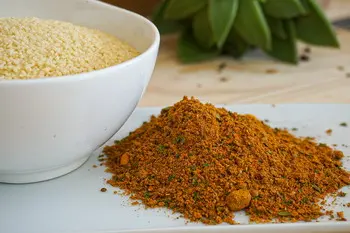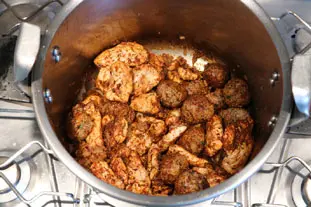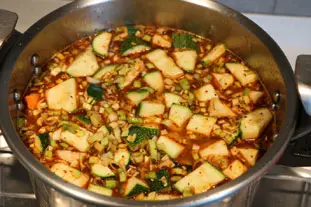This site uses only a few technical cookies necessary for its operation. By continuing to browse, you accept their use.
To find out more...
To find out more...
Roasting spices

If you like your food a little, or a lot, spicy, you'll no doubt have a jar or sachets of mixed spices in your cupboards from which to draw when preparing a dish.
I'm thinking, for example, of curries, chili and couscous, all of which fill the kitchen, and sometimes far beyond...
I'm thinking, for example, of curries, chili and couscous, all of which fill the kitchen, and sometimes far beyond...
9,901 4.9/5 (16 reviews)
Keywords for this post:TastesFlavorsSpicesRoastingLast modified on: October 30th 2020
Roasting spices
At some point in the creation of your recipe, you will add the spices of your choice, in proportions to suit your own taste or that of your guests. The question is: when should you add them, is there a better time than another?
In most recipes, spices are added at just about any time, so it doesn't really matter, as the dish usually cooks for a long time and the aromas have plenty of time to develop.
This isn't quite true: in truth, there is an optimum moment, and it's not when the dish is practically finished - quite the contrary.
What we're all trying to achieve is that the spices reveal themselves completely with cooking, especially if they've been in their jars or sachets for (a little too) long, where they've had a chance to "pass through" a little.
The ideal way to cook spices is to roast them, i.e. cook them, almost on their own, to reveal their flavours before putting them in contact with all the other foods.
For the recipes mentioned above, you'll have a meat base that will be cooked for a long time with spices, so here's how to do it:
- To begin with, place the meat, generally cut into pieces, in your saucepan, casserole or stewpot, add a little fat, and brown it, i.e. grill just the surface, over a very high heat.
- Once it's done, it's time to add the spices all at once (the powerful smells will jump out at you, so light your hood if you haven't already), stirring well to coat the meat with them, it's very dry, a little strange, agglomerated, not to worry.
- Then continue as normal, adding the vegetables or kidney beans, water, etc. etc.
It's quite simple, with few constraints, and you'll see that the results are just as good.
To sum up: if you're making a recipe that contains powdered spices, try roasting them and cooking them on their own or with just the meats before continuing with the recipe, as they'll taste much better.
In most recipes, spices are added at just about any time, so it doesn't really matter, as the dish usually cooks for a long time and the aromas have plenty of time to develop.
This isn't quite true: in truth, there is an optimum moment, and it's not when the dish is practically finished - quite the contrary.
What we're all trying to achieve is that the spices reveal themselves completely with cooking, especially if they've been in their jars or sachets for (a little too) long, where they've had a chance to "pass through" a little.
The ideal way to cook spices is to roast them, i.e. cook them, almost on their own, to reveal their flavours before putting them in contact with all the other foods.
For the recipes mentioned above, you'll have a meat base that will be cooked for a long time with spices, so here's how to do it:
- To begin with, place the meat, generally cut into pieces, in your saucepan, casserole or stewpot, add a little fat, and brown it, i.e. grill just the surface, over a very high heat.
- Once it's done, it's time to add the spices all at once (the powerful smells will jump out at you, so light your hood if you haven't already), stirring well to coat the meat with them, it's very dry, a little strange, agglomerated, not to worry.

- Then continue as normal, adding the vegetables or kidney beans, water, etc. etc.

It's quite simple, with few constraints, and you'll see that the results are just as good.
To sum up: if you're making a recipe that contains powdered spices, try roasting them and cooking them on their own or with just the meats before continuing with the recipe, as they'll taste much better.
Lasts posts
Butter vs. grease
We often read in a recipe where a pastry is put into a mould that, just before pouring, the mould should be buttered or greased. But what's the difference between these 2 terms?December 1st 20251,5025
Getting out of the fridge early
Very often when you're cooking, you need to take food or preparations out of the fridge, to use them in the recipe in progress. There's nothing tricky about this: you just take them out of the fridge and use them, usually immediately, in the recipe. But is this really a good method?November 24th 20251,2905
Who's making the croissants?
When you look at a bakery from the outside, you naturally think that in the bakery, the bakers make the bread, and in the laboratory, the pastry chefs make the cakes. It's very often like that, with each of these professions having quite different ways of working, but sometimes there's also one...November 23th 20251,182
Oven height
When we put a dish or cake in the oven, we naturally tend to put it on the middle shelf, and that's what we usually do. But in some cases, this position and height can be a little tricky, so let's find out why.October 8th 20253,3545
The importance of sieving
In recipes that use a fine powder (flour, powdered sugar, etc.), you'll often see the advice to sift before using it. To sift is to pass the powder in question through a sieve (a very fine strainer) before incorporating it into your recipe. It's often advice, but is it really useful?September 3rd 20257,9573
Other pages you may also like
The power of sayings and beliefs in the kitchen
One day, in the comments on the recipe for beaten egg whites, a young woman asked if you could beat egg whites stiff while having a period, as a friend had told her it wasn't possible. Sometime later another person commented that for mayonnaise it had been (get this!) scientifically proven that a...February 6th 201152 K4.4
Candied fruits: don't get ripped off
Do you like candied fruit? You might like to nibble a handful or add it to a recipe, like a classic fruit cake or delicious Italian specialities like panettone or sicilian epiphany pie.June 21th 201768 K 24.2
Should a sausage be pricked before cooking?
If you are using sausages in a recipe, you may have already asked yourself the question: Should you prick it before cooking it, or not? You will certainly find as many opinions "you should prick" as "you should not". Let's try to untangle all this.September 29th 201848 K4.1
Soup vs. potage
It's true that we're finally coming out of winter as I write these lines, and that we'll all be making, no doubt, a little less soup and potages, but even if it's out of season, it really is a simple and delicious dish, which is one of the always easy answers to "What's for dinner this (Sunday)...April 9th 202211 K
Too much sweet and savoury
There is a food trend which is creeping in everywhere in France right now: mixing sweet with savoury. In some restaurants, it is becoming difficult to order a classic dish, like “roast veal” for instance, without being served fruits in the garnish or honey/conserves/syrup in the sauce or cooked...November 3rd 201127 K4.5
Post a comment or question
Follow this page
If you are interested in this page, you can "follow" it, by entering your email address here. You will then receive a notification immediately each time the page is modified or a new comment is added. Please note that you will need to confirm this following.
Note: We'll never share your e-mail address with anyone else.
Alternatively: you can subscribe to the mailing list of cooling-ez.com , you will receive a e-mail for each new recipe published on the site.









